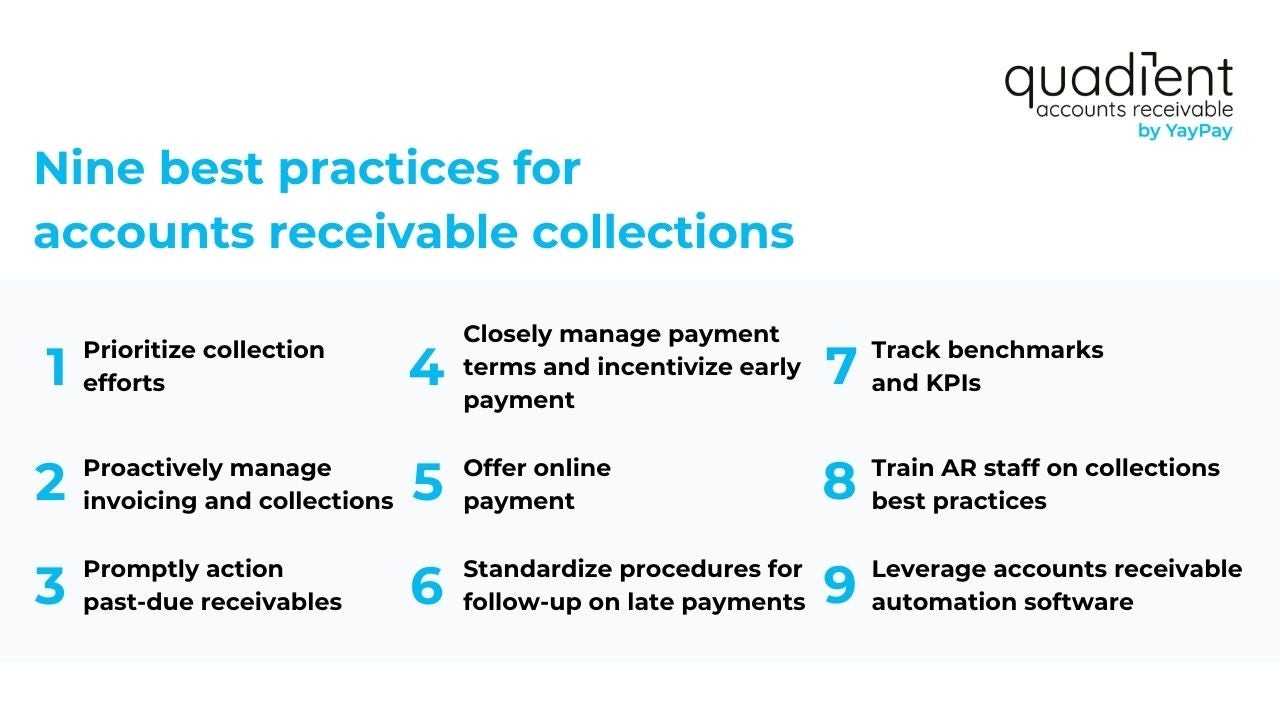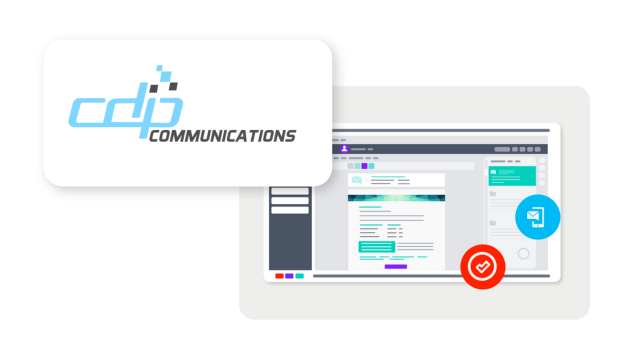Introduction
As a business grows, managing cash flow becomes increasingly critical. One of the most effective ways to maintain a healthy cash flow is to optimize the accounts receivable (AR) collections process. As such, leading organizations are continually seeking ways to accelerate payments. To achieve this, accounting departments need to implement best practices that ensure efficient accounts receivable collections. In this article, we'll explore nine accounts receivable collections best practices that today’s leading AR departments use to prevent cash flow problems from spiraling out of control.
Definition of accounts receivable collections
Accounts receivable collection is the process of collecting payments from customers who owe money to a business for goods or services rendered. The accounts receivable collections process typically involves sending invoices or statements to customers, following up on past-due accounts, and recording payments as they are received.
Benefits of good AR collection practices
Effective accounts receivable collections are critical to maintaining the financial health of a business, as they help to ensure that cash flow remains consistent and that outstanding debts are kept to a minimum. A good collections process is one that brings money into the business quickly to strengthen cash flow and deliver working capital improvements.
Featured Resource: ➜ The 2024 AR Collections Best Practices eBook

Nine best practices for accounts receivable collections

1. Prioritize collection efforts: Identify and focus on the most overdue accounts that have a higher likelihood of payment. By prioritizing accounts, businesses can optimize their resources and increase the likelihood of receiving payment for outstanding invoices, which in turn improves cash flow and reduces the risk of bad debt.
2. Proactively manage invoicing and collections: Establish clear payment terms and promptly send invoices to customers. By staying on top of invoicing, you can reduce the likelihood of disputes and delays in payment. Proactively managing collections means systematically monitoring payment due dates and following up with customers before payment is overdue. This not only helps to maintain positive relationships with customers but also ensures that payments are received in a timely manner.
3. Promptly action past-due receivables: Conduct regular internal reviews of past-due accounts and act on them immediately. Scheduling monthly meetings for this purpose can be beneficial in ensuring that everyone is financially aligned and aware of any outstanding accounts.
4. Closely manage payment terms and incentivize early payment: Establish a standard payment policy and provide incentives, such as discounts, for early payment. Setting the shortest possible set of payment terms upfront will reduce collection complexities down the line, especially since some customers will want to negotiate their terms. You can also increase the likelihood of on-time payment by pointing out your payment policy and your incentives for early payment during the sales process.
5. Offer online payment: Giving your customers the option to pay invoices online increases the likelihood of payment by 30%. Online payment allows your customers to pay their invoices faster compared to sending a check in the mail. Better yet, provide a customer portal to encourage prompt payments and proactive management of account status.
6. Standardize procedures for follow-up on late payments: Institute clear processes to identify and address past-due accounts. This will ensure that all accounts are being handled consistently and that no accounts fall through the cracks. This will not only improve your chances of collecting payment but also help build a better relationship with your customers by showing that you have a professional and organized approach to collections.
7. Track benchmarks and KPIs: No matter how effective your collections process is, you can almost certainly make it better. A simple way to do this is by establishing benchmarks, key performance indicators (KPIs), and other metrics and consistently tracking them for improvement.
Useful metrics to measure include:
- Days sales outstanding (DSO) measures how fast, on average, your customers are paying you from the date of sale or invoice. The lower the number, the better. A high DSO may indicate that your collections efforts aren’t working as effectively as they should be.
- Average days delinquent (ADD) measures the amount of time, on average, that it takes a customer to pay a bill after the invoice is due.
- Collection effectiveness index (CEI) measures the ability of your collections staff to collect funds from customers.
8. Train AR staff on collections best practices: Ensure that all relevant personnel are trained on collections policies, procedures, and best practices. This should include new employees and documentation of the training should be maintained. Consider implementing periodic mandatory training for all AR staff to review and refresh their knowledge.
9. Leverage accounts receivable automation software: If your accounting department still relies on manual accounts receivable processes, it may be time to consider switching to an automated AR solution.
Modern AR software automates tasks such as sending invoices, following up on late payments, and tracking metrics. The software can help streamline AR management and save your team valuable time. With an automated system in place, your AR specialists can focus on providing excellent customer service and driving revenue rather than being bogged down by tedious administrative tasks.
How automation can help your collection efforts
According to a recent survey by Quadient AR by YayPay, fewer than 30% of organizations have implemented automation into their collections processes, despite it being a key part of the C2C lifecycle that generates revenue. More than half of the companies surveyed indicated that they have limited automation or no automation in place.
Incorporating automation into the collections stage of your C2C process can boost your cash flow and expedite your operations.
Here are some key ways that automation can help your collections efforts:

- Payment reminders: Automated communications, such as emails or texts, can be used to send friendly "upcoming payment due" notices and past due reminders. This encourages customers to make timely payments in a professional and cordial manner.
- Inbound requests: You can save your team significant time and effort by automating responses to common inbound requests received over email or through your AR system. Machine learning (ML) technology can recognize the type of request and send an appropriate response, such as payment link requests, unsubscribe requests, invoice copy requests, or PO number requests.
- Repetitive processes: Automating cadences and workflows for follow-ups and dunning letters, tracking open rates, reporting on bounces, and supporting internal and external notes can eliminate duplication of effort when multiple resources interact with the same customer.
- Process clarity: Automation establishes a systematic approach, ensuring a consistent and clearly communicated process. This ensures that customers know what to expect during the collections process, resulting in positive interactions.
Whether your goal is to reduce costs, improve efficiency, or decrease your Days sales outstanding (DSO), automation is a valuable strategy that can benefit your business. Take advantage of the opportunities available in your collections process to gain a competitive edge and accelerate your cash flow as you assess your C2C process.
Conclusion
Optimizing accounts receivable (AR) collections is critical to maintaining the financial health of a business. The implementation of these best practices can significantly improve the efficiency and effectiveness of your AR collections process. Incorporating automation into your collections efforts can provide numerous benefits, such as boosting cash flow and expediting operations. Therefore, businesses should consider adopting these best practices and automation solutions to prevent cash flow problems from spiraling out of control and ensure the financial stability of their organization.







